Quenching the Built Environment's Thirst for Water
Refuse to resource
Rainwater is not the only source of reclaimed water suitable for nonpotable applications within buildings. A few institutional and commercial buildings treat and reuse on-site-generated wastewater. One such project is the 351-bed dormitory under construction at Emory University in Atlanta, which will include a system for recycling graywater (wastewater generated from nonindustrial processes such dishwashing, bathing, and laundry, and excluding water from kitchen sinks and toilets). The dorm, designed by Ayers/Saint/Gross and slated for completion in 2010, will capture shower and lavatory water and will use it for toilet flushing after filtering and chlorination with sodium hypochlorite. The system is expected to save 1 million gallons of potable water annually.
Another type of on-site wastewater treatment, known as an a "Eco-Machine," mimics nature and relies on beneficial bacteria, plants, fish, and other organisms to break down and consume pollutants in water. A recently installed Eco-Machine at the Omega Center for Holistic Studies, in Rhinebeck, New York, replaces the 195-acre campus's traditional septic tank and leaching field system and can handle both graywater and blackwater (sewage) from 700 guests, or 52,000 gallons each day.
In a cycle that takes about two and a half days, the Omega wastewater travels through a system that includes underground anaerobic tanks, constructed wetlands, and aerated lagoons. Along the way, contaminants such as nitrates and ammonia are removed. The process also greatly reduces levels of total suspended solids (TSS) and biological oxygen demand (BOD). Both are measures of water quality, but TSS refers to suspended material in water, either organic or inorganic, while BOD refers to the rate of uptake of dissolved oxygen and is an indication of the presence of organic material, explains Jonathan Todd, president of Woods Hole, Massachusetts-based John Todd Ecological Design, the Omega system's designer.
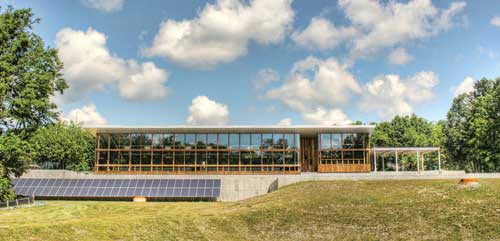 |
|
The Omega Center for Sustainable Living has a south-facing glass facade (above) with an integrated sunshade. It provides the sunlight that the aerated lagoons' plants need to thrive while protecting them from direct solar exposure in the summer. Photo: © Andy Milford |
|
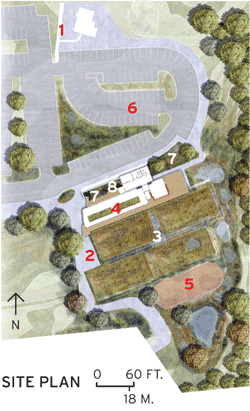 |
LEFT Â Â Â Â BOTTOM |
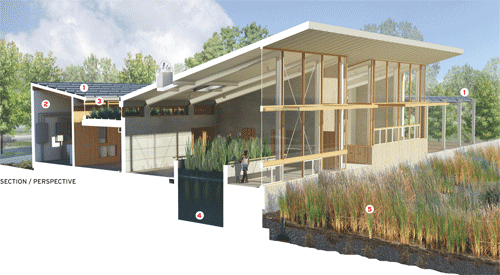 |
|
Â
At Omega, a new building, the Center for Sustainable Living, houses part of the treatment process and has a classroom and a small lab where the institute plans to teach guests, students, and the public about the filtration system, the water cycle, and sustainable design. The institute hopes the center will achieve certification under the Living Building program created by the Cascadia Green Building Council to encourage construction of self-sustaining facilities. To that end, the center includes several tightly coordinated features, such as photovoltaics that supply all of the power necessary for operation and an integrated set of landscape and water systems. "The building is basically a pedagogical tool," explains Laura Lesniewski, AIA, a principal at Kansas City, Missouri-based BNIM, the center's architect.
 |
The Omega building houses aerated lagoons where the roots of wetland plants act as habitat for microbial populations that scrub the water. Photo: © Andy Milford |
Inside the center, toilets are flushed with roof runoff stored in an underground, 1,800-gallon cistern, while the toilets elsewhere on the campus rely on well water. Omega plans to collect operations data and apply for a reuse permit so that it can eventually implement a closed-loop system, with the Eco-Machine supplying water for toilet flushing and irrigation campuswide. But for now, the clean Eco-Machine water infiltrates the aquifer that sits below the Omega property and feeds a nearby lake. Rainwater falling on the site follows a similar path, first traveling through an integrated system of bioretention swales, rain gardens, and wetland cells. The strategies ensure that storm water, along with Eco-Machine-treated water, reaches the lake much cooler and cleaner than surface runoff would, according to Tom Price, a principal for Omega's landscape architect, Conservation Design Forum, in Elmhurst, Illinois. The temperature of the water is important for the flora and fauna living in the lake and for the surrounding wetlands, he explains.
Across the continent, on Vancouver's waterfront, the recently completed 1.1-million-square-foot expansion to that city's convention center has a treatment system hidden in its base that directs blackwater to toilet flushing and to irrigation of a 6-acre green roof. But instead of an Eco-Machine, designers chose a process that relies on a membrane bioreactor, ultraviolet light, and activated charcoal, partly because of space constraints and structural issues. An Eco-Machine's plants require sunshine, so the likely spot for its tanks would have been the roof - a problematic configuration in a seismically active zone, points out Blair McCarry, a principal in the local office of Stantec, the project's m/e/p engineer. "The secondary costs became prohibitive," he says.
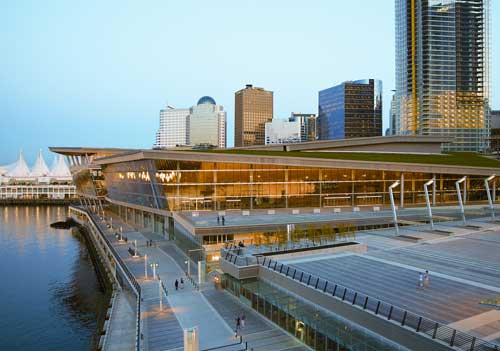 |
|
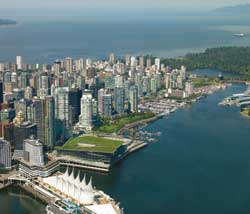 |
Designers took advantage of the Vancouver Convention Center's site on the harbor by incorporating seawater into several of the expansion's building systems, including the blackwater treatment system (below), which has desalination backup. The treated blackwater is used to flush toilets and irrigate the convention center's 6-acre green roof. According to the project team, it is the largest nonindustrial planted roof in North America. Photos: © Vancouver Convention Center |
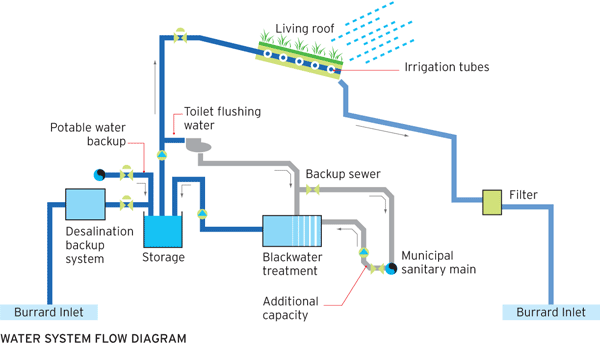
Since the supply of wastewater will vary with occupancy, the convention center system has several backup options for toilet flushing and roof irrigation, including the municipal blackwater and potable water systems. It also has an on-site desalination plant. Although removing salt from water can be an energy-intensive process, here it makes sense because the site is on the harbor, says Tom Burgess, AIA, project manager for Seattle-based LMN, the expansion project's design architect. The building also has a seawater heat-pump and cooling system and a seawater fire-suppression system. "Because the building is over the water, we are taking advantage of it," he says.









